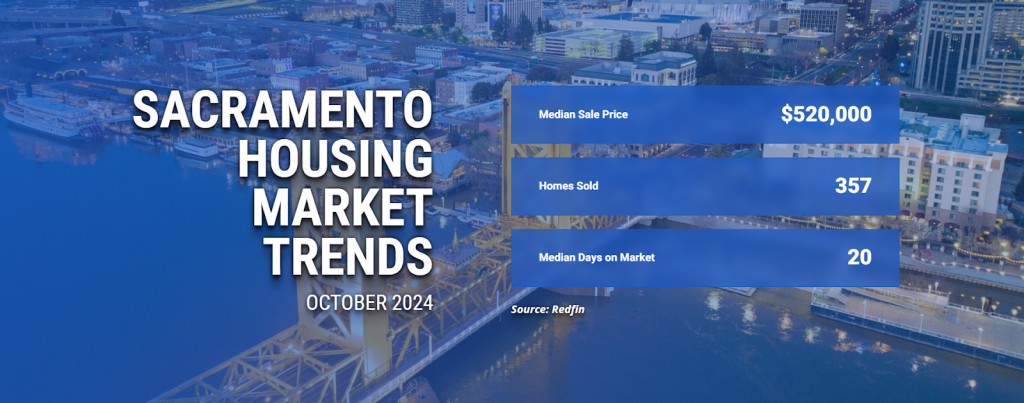2024 Sacramento Housing Market Trends
Sacramento’s housing market is buzzing with activity, and whether you’re buying, selling, or just curious, there’s a lot to unpack. Home prices are climbing, buyer behaviors are shifting, and new policies are reshaping how homes are built in the city. It’s an exciting time that calls for a good understanding of the trends. If you’re looking to move or stay in the loop, here’s what you need to know about what’s going on in Sacramento real estate right now.


October 2024
The Sacramento housing market has recently seen some interesting changes shaped by the economy and local policies.
Home Prices Are Rising
According to Redfin, the median home price in Sacramento reached $520,000 as of October 2024, a 2.0% jump from last year. This steady increase shows that demand for homes in the area is staying strong.Homes Are Taking Longer to Sell
On average, homes spend 20 days on the market, compared to just 13 days a year ago. While homes aren’t flying off the market as quickly, this slight slowdown gives buyers more time to make decisions.Competition Is Still Fierce
Even with homes staying on the market longer, Sacramento remains a competitive market. Many properties are getting multiple offers, sometimes with waived contingencies. On average, homes sell for their asking price, but the hottest listings are selling for 2% over and going under contract in about eight days. However, “Ryan Lundquist, a real estate analyst in the Sacramento area, said Wednesday that 44% of homes listed for sale right now in Sacramento have had to drop the price,” states this CBS article.Sales Are Picking Up
According to Redfin, 358 homes were sold in Sacramento in October 2024. This is a noticeable jump from the 294 sold during the same time last year. This uptick signals that buyer interest is still strong despite changing conditions.A Look at the Bigger Picture
“Sacramento’s median sale price is 10% higher than the national average. Overall cost of living in Sacramento is 27% higher than the national average,” states Redfin. These figures highlight the city’s growing popularity and economic strength, even as affordability becomes a challenge for some. Sacramento’s housing market is evolving, but whether you’re a buyer or seller, it’s clear that the demand for homes in this vibrant city isn’t going anywhere.What This Means for Homeowners and Buyers
For homeowners, Sacramento’s rising home prices mean increased equity and potential for higher profits if you’re looking to sell. The market’s competitiveness also works in your favor, as well-priced homes still attract multiple offers. However, the slight slowdown in how quickly homes sell may require more patience or a strategic approach to staging and pricing your property. For buyers, the increased days on the market provide a little breathing room, making it easier to evaluate options without the pressure of immediate competition. That said, the market is still competitive, and desirable properties are moving fast. Staying pre-approved and ready to make an offer remains key. Rising home prices and living costs highlight the importance of setting a realistic budget and preparing for potential bidding wars. Understanding these trends can help you make confident decisions in Sacramento’s dynamic housing market, whether you’re buying or selling.How Sacramento Compares to Other Major California Cities, October 2024
Sacramento’s housing market is more affordable and offers more growth potential than other major California cities. Here’s how it stands alongside Los Angeles, San Francisco, and San Diego:Median Home Prices
- Sacramento: According to Redfin, the median home price is $520,000 as of October 2024, reflecting a 2.0% year-over-year increase.
- Los Angeles: According to Los Angeles Almanac, the median home price in LA is approximately $956,210 as of October 2024. This indicates a higher cost of living in Los Angeles than in Sacramento.
- San Francisco: According to the California Association of Realtors, the median home sales price in San Francisco is $1.315 million. San Francisco remains one of the nation’s most expensive markets.
- San Diego: According to the Los Angeles Almanac, the median home price is about $1,010,000, driven by strong demand and coastal appeal.
Cost of Living
- Sacramento: “The cost of living in Sacramento is 30% less expensive than in San Francisco. Cities ranked 501st and 9th ($2656 vs $3781) in the list of the most expensive cities in the world and ranked 443rd and 7th in the United States,” states LivingCost.
- Los Angeles: “The cost of living in Los Angeles is 20% more expensive than in Sacramento. Cities ranked 72nd and 501st ($3187 vs $2656) in the list of the most expensive cities in the world and ranked 59th and 443rd in the United States,” states LivingCost.
- San Francisco: Known for its high cost of living, it’s significantly more expensive than Sacramento. According to LivingCost, the monthly average cost of living for one person in Sacramento is $2656, while it is $3781 in San Francisco.
- San Diego: According to NerdWallet, “The cost of living is 20% higher [in San Diego than Sacramento].”
Market Dynamics
- Sacramento: According to Redfin, homes spend an average of 20 days on the market, with many receiving multiple offers. This reflects a slower pace than last year but maintains a competitive edge.
- Los Angeles: Properties typically spend about 30 days on the market, indicating a more balanced pace between buyers and sellers. (California Association of Realtors)
- San Francisco: According to Redfin, “On average, homes in San Francisco sell after 19 days on the market compared to 24 days last year.”
- San Diego: “On average, homes in San Diego sell after 27 days on the market compared to 18 days last year,” states Redfin as of October 2024.
Growth and Development Potential
- Sacramento: The 2040 General Plan aims to boost housing density and affordability, positioning the city for growth.
- Los Angeles and San Diego: Both face housing shortages and zoning challenges that may constrain growth.
- San Francisco: Limited land and high costs restrict growth, making it a challenging market for buyers and developers.








